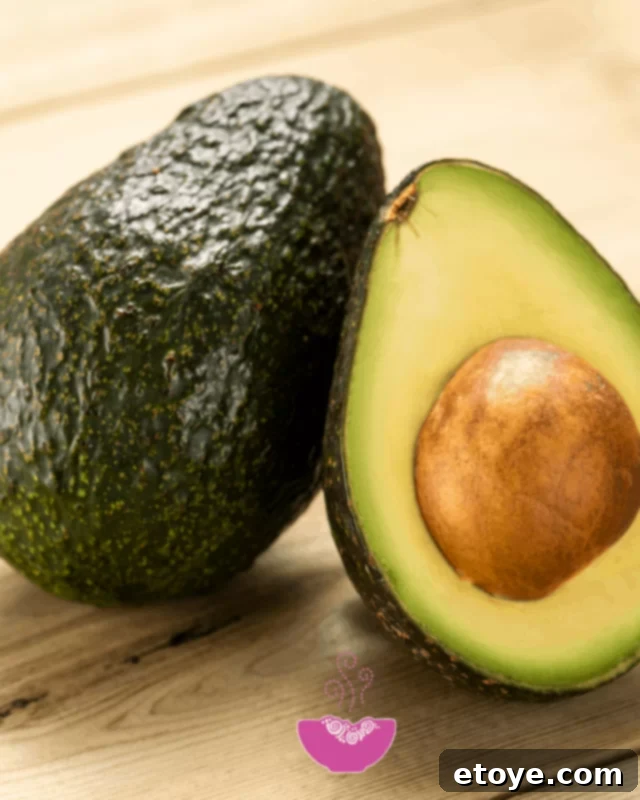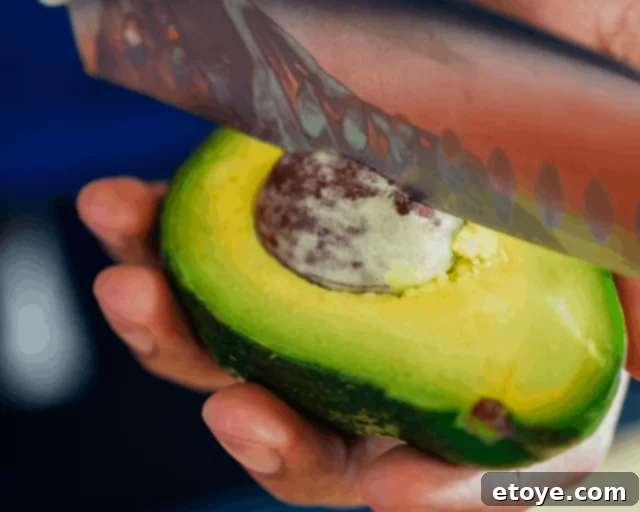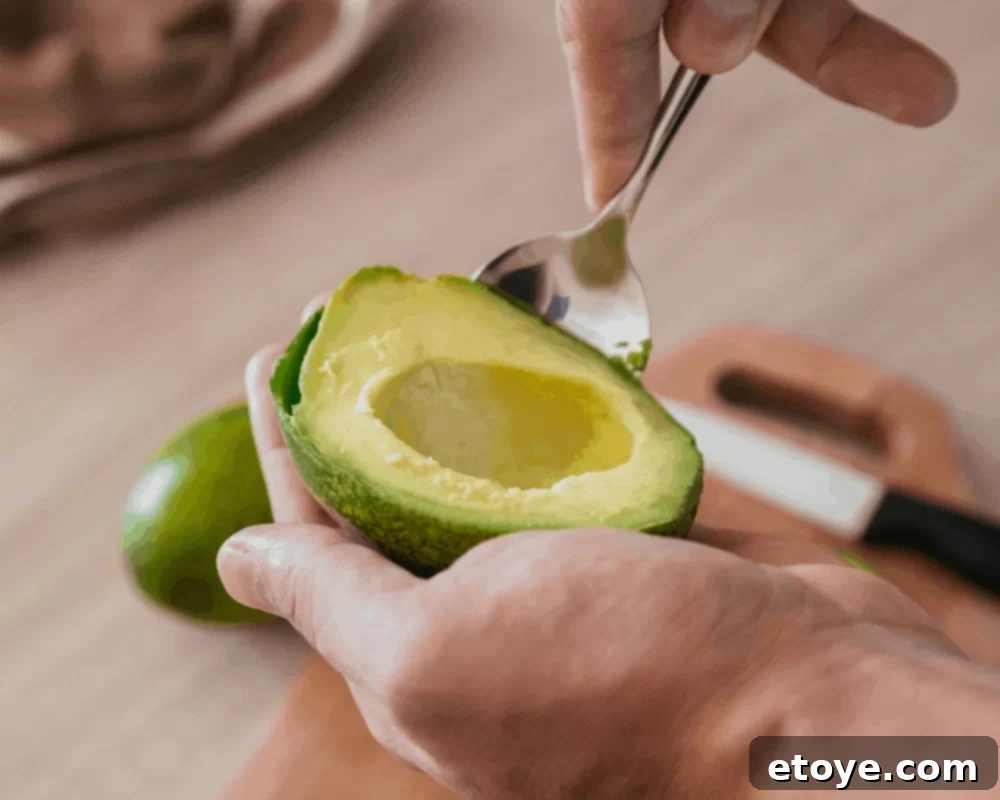Mastering the art of cutting an avocado can elevate your culinary creations, transforming simple meals into nutrient-dense, flavorful dishes. A few perfectly sliced pieces of ripe avocado can turn your ordinary Buddha Bowl into a vibrant, fresh green masterpiece, brimming with healthy fats, essential vitamins, and dietary fiber. This comprehensive guide will walk you through the process, ensuring you can confidently prepare this versatile superfood every time.

Unlocking the Potential of Your Buddha Bowl: Essential Kitchen Basics

Embarking on the journey of creating delightful Buddha Bowls begins with mastering fundamental kitchen skills. These simple techniques not only help you prevent food waste but also empower you to infuse incredible flavor into every bowl. Among these crucial skills, learning how to expertly cut an avocado stands out. While its large pit can seem daunting and confusing at first, rest assured, we’re here to demystify the process and teach you the safest and most efficient way to slice this creamy fruit.
A well-prepared Buddha Bowl is a harmonious blend of various components: wholesome grains, fresh greens, protein sources, an array of colorful vegetables, delectable sauces, and thoughtful toppings. Each element contributes to a balanced, satisfying, and incredibly nutritious meal. By understanding basic preparations, such as handling tricky ingredients like avocados, you unlock a world of culinary possibilities. It’s about building confidence in the kitchen and making healthy eating an enjoyable and accessible experience.
Ready to explore more? Dive into our extensive collection of Buddha Bowl recipes to discover inspiring combinations for your grains and greens, proteins, veggies, sauces, and toppings here!
Why Learning to Cut an Avocado is a Game-Changer
Avocados are nutritional powerhouses, packed with monounsaturated fats, fiber, and a wide array of vitamins and minerals. However, their unique structure, particularly the large central pit, can intimidate many home cooks. The fear of cutting oneself or fumbling with the slippery flesh often deters people from incorporating this superfood into their daily diet. Learning the correct technique not only ensures safety but also allows you to fully enjoy the creamy texture and rich flavor of avocados in countless dishes, from salads and sandwiches to smoothies and, of course, Buddha Bowls.
Beyond convenience, proper cutting methods help preserve the avocado’s delicate flesh and prevent unnecessary waste. An efficiently cut avocado means more delicious goodness for your meals. This simple skill is a fundamental step towards embracing healthier eating habits and expanding your culinary repertoire. Let’s conquer the avocado together!
How to Cut an Avocado – A Detailed Step-by-Step Guide
Cutting an avocado safely and efficiently is a skill that, once mastered, will serve you well in countless recipes. Follow these steps for perfect avocado slices or cubes every time:
Step 1: Halving the Avocado Safely Around the Pit
Begin by holding the avocado securely in one hand. It’s crucial to use a firm grip to prevent the avocado from slipping. With a sharp chef’s knife, carefully cut lengthwise around the large pit. Start at one end, pressing the knife blade into the avocado until you feel the pit. Then, rotate the avocado while keeping the knife pressed against the pit, creating a clean cut all the way around until you meet your starting point. Ensure your fingers are safely away from the knife’s path at all times. The goal is to slice through the skin and flesh without cutting into the pit itself.

Step 2: Separating Halves and Expertly Removing the Pit
Once you’ve cut all the way around, gently twist the two halves of the avocado apart. They should separate cleanly, revealing one half with the pit and one half without. To remove the pit, carefully but firmly whack the sharp edge of your knife into the pit. The knife should stick into the pit, providing a secure grip. Then, with a gentle twist of the knife, the pit should easily dislodge. Always ensure your non-knife hand is clear of the avocado and knife blade during this step. If you plan to save half of the avocado for later, always save the half that still contains the pit. The presence of the pit helps to reduce the avocado’s exposure to oxygen, significantly slowing down the browning process and keeping it fresh for a longer period.

Step 3: Scooping Out the Creamy Flesh
Now that the avocado is halved and the pit is removed, it’s time to retrieve the delicious flesh. Take a large spoon – a sturdy soup spoon or a specific avocado scooper works best – and gently run it along the inside edge of the avocado skin. Work your way around the entire perimeter, scooping out the flesh in one clean motion. This method ensures you get as much of the creamy goodness as possible without leaving any behind. You can scoop out the entire half in a single piece, or scoop in smaller sections depending on how ripe your avocado is.

Step 4: Precision Slicing on Your Cutting Board
With the avocado flesh removed, place it flat side down on your cutting board. Using your knife, begin to slice the avocado into your desired thickness. For elegant salads or gourmet toast, aim for thin, even slices. For chunky guacamole or hearty Buddha Bowls, thicker slices or cubes might be more appropriate. Always use a sharp knife and maintain a steady hand for clean cuts. This technique provides excellent control and safety compared to slicing directly within the avocado skin.

Advanced Tips and Alternative Methods for Cutting Avocado
While the step-by-step guide above is ideal for clean slices, there are other useful techniques for different culinary applications, especially when you need cubed avocado or want to avoid extra cleanup.
The Cross-Hatch Method for Cubes
Another popular and efficient way to prepare an avocado, particularly for guacamole or chunky salads, is the “cross-hatch” method. After halving the avocado and removing the pit (as described in steps 1 and 2), hold one half firmly in your hand. Using a paring knife, carefully score the flesh in a cross-stitch or grid pattern, making cuts down to the skin but not through it. Once you’ve created your desired cube size within the skin, use a large spoon to scoop out the pre-cubed avocado. This method is incredibly convenient as it eliminates the need to transfer the avocado to a cutting board for cubing and helps keep your hands clean.
Choosing the Perfect Avocado
The success of cutting an avocado often starts with selecting the right one. Look for avocados that are dark green to purplish-black (for Hass avocados) and yield slightly to gentle pressure when squeezed. If it’s too soft, it might be overripe and mushy; if it’s too firm, it’s not ripe enough and will be hard to cut and less flavorful.
Preventing Avocado from Browning
Avocados notoriously brown quickly once cut due to oxidation. To slow this process, aside from saving the pit with one half, you can:
- Lemon or Lime Juice: Squeeze a little lemon or lime juice directly onto the exposed flesh. The acidity acts as a natural preservative.
- Airtight Container: Store any leftover avocado in an airtight container in the refrigerator.
- Onion Trick: Place the avocado half in an airtight container with a slice of raw onion. The sulfur compounds released by the onion can help inhibit browning.
Essential Safety Reminders
Working with sharp knives requires caution, especially with round, sometimes slippery, avocados. Always cut on a stable surface, use a sharp knife (dull knives are more dangerous as they require more force), and keep your non-cutting hand safely away from the blade. Never try to hold an avocado with one hand and cut the pit out with the other while holding it in the air; always perform this step on a sturdy cutting board or with extreme caution as described in our guide.
The Nutritional Powerhouse: Benefits of Avocados
Beyond their delicious taste and creamy texture, avocados are revered for their impressive nutritional profile, making them a staple in healthy diets and a perfect addition to any Buddha Bowl.
- Heart-Healthy Fats: Avocados are rich in monounsaturated fatty acids, particularly oleic acid, which is known for its ability to reduce bad cholesterol levels and promote cardiovascular health.
- Fiber-Rich: A single avocado contains a significant amount of dietary fiber, crucial for digestive health, promoting satiety, and helping to regulate blood sugar levels. This makes them excellent for weight management.
- Packed with Vitamins & Minerals: They are an excellent source of Vitamin K, Vitamin C, Vitamin B6, Vitamin E, Folate, and Potassium. These nutrients play vital roles in bone health, immune function, energy metabolism, and nerve function.
- Powerful Antioxidants: Avocados contain powerful antioxidants like lutein and zeaxanthin, which are beneficial for eye health and can help protect against age-related macular degeneration.
- Nutrient Absorption: The healthy fats in avocados also help your body absorb fat-soluble vitamins (A, D, E, K) from other foods you eat, making them a fantastic addition to colorful vegetable-filled Buddha Bowls.
Beyond the Bowl: Creative Ways to Enjoy Avocados
While avocados are a star in Buddha Bowls, their versatility extends to countless other culinary applications:
- Classic Guacamole: Mash with lime juice, cilantro, onion, and jalapeño for the ultimate dip.
- Avocado Toast: A simple yet satisfying breakfast or snack, mashed or sliced on your favorite bread.
- Smoothies: Add a quarter of an avocado to smoothies for creaminess, healthy fats, and a nutritional boost without altering the taste much.
- Salads: Cube or slice into any salad for added richness and satiety.
- Desserts: Believe it or not, avocados can be used in desserts like chocolate avocado mousse for a surprisingly rich and creamy treat.
- Egg Topping: Sliced avocado makes a perfect topping for scrambled eggs, omelets, or fried eggs.
- Sandwich & Wrap Spreads: Mash avocado with a pinch of salt and pepper for a healthier alternative to mayonnaise.
From enhancing your Buddha Bowl to starring in countless other dishes, mastering the simple skill of cutting an avocado opens up a world of healthy and delicious possibilities.
If you have tried cutting an avocado using these tips, or any recipes on my blog, then please rate it and let me know how it turned out in the comments below! Your feedback is invaluable and helps our community grow and learn together.
